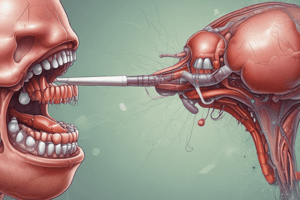Podcast
Questions and Answers
Which of the following is a common mode of transmission for hepatitis B?
Which of the following is a common mode of transmission for hepatitis B?
- Eating contaminated food
- Mother-to-child transmission during birth (correct)
- Sharing personal care items
- Casual contact such as hugging or kissing
What is the primary way to prevent hepatitis B infection?
What is the primary way to prevent hepatitis B infection?
- Avoiding casual contact with infected individuals
- Sharing personal care items
- Receiving the hepatitis B vaccine (correct)
- Using unsterilized medical equipment
What is the purpose of the HBsAg test in diagnosing hepatitis B?
What is the purpose of the HBsAg test in diagnosing hepatitis B?
- To detect the presence of the virus (correct)
- To detect immunity to the virus
- To determine the severity of symptoms
- To assess liver function
What is the typical course of treatment for acute hepatitis B?
What is the typical course of treatment for acute hepatitis B?
Which of the following is a risk group for whom the hepatitis B vaccine is recommended?
Which of the following is a risk group for whom the hepatitis B vaccine is recommended?
What is the purpose of booster shots in the hepatitis B vaccine series?
What is the purpose of booster shots in the hepatitis B vaccine series?
Flashcards are hidden until you start studying
Study Notes
Hepatitis B
Vaccination
- Hepatitis B vaccine is the most effective way to prevent infection
- Recommended for all newborns, and for individuals at high risk (healthcare workers, people with chronic liver disease, etc.)
- Vaccine is given in a series of 2-4 doses, depending on age and risk group
- Booster shots may be necessary to maintain immunity
Transmission
- Hepatitis B is primarily spread through:
- Blood and bodily fluids (sex, sharing needles, etc.)
- Mother-to-child transmission during birth
- Contaminated medical equipment
- Can also be spread through:
- Tattooing and piercing with unsterilized equipment
- Sharing personal care items (razors, toothbrushes, etc.)
- Casual contact (hugging, kissing, etc.) is not a common mode of transmission
Diagnosis
- Blood tests are used to diagnose hepatitis B:
- HBsAg (hepatitis B surface antigen) test: detects presence of the virus
- Anti-HBs (hepatitis B surface antibody) test: detects immunity
- Liver function tests (LFTs) and liver biopsy may also be performed
Treatment
- Acute hepatitis B usually resolves on its own
- Chronic hepatitis B requires antiviral medication to manage the infection and prevent liver damage
- Treatment options include:
- Nucleos(t)ide analogues (e.g. lamivudine, adefovir)
- Interferon therapy (for some patients)
- Liver transplantation may be necessary for advanced liver disease
Symptoms
- Symptoms may not appear until 2-6 months after infection
- Common symptoms include:
- Fatigue
- Loss of appetite
- Nausea and vomiting
- Abdominal pain
- Dark urine and pale stools
- Yellowing of the skin and eyes (jaundice)
- Some people may not exhibit symptoms at all
Studying That Suits You
Use AI to generate personalized quizzes and flashcards to suit your learning preferences.




